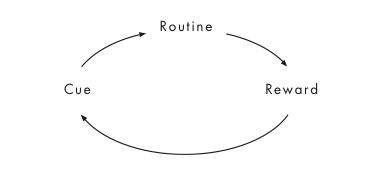Habits make up 40 percent of our daily behaviors, according to studies. And yet, because habits unfold within our basal ganglia – one of the oldest parts of the brain – they often feel nearly unconscious. So how do you change a habit? By diagnosing it’s components, and reprograming the behavior. Here’s how to do just that:
1. Identify your habit’s routine
There is a basic pattern at the core of every habit, a kind of neurological loop that has three parts: A cue, a routine and a reward.
To understand your habit, you need to identify the components of your loop. The easiest place to start is with the routine: what behavior do you want to change? (For instance, I once had a bad habit of eating a cookie from the cafeteria every afternoon.)
2. Experiment with different rewards
Rewards are powerful because they satisfying cravings. But we’re often not conscious of the cravings that drive our behaviors. To figure out which cravings are driving particular habits, it’s useful to experiment with different rewards. For instance, on the first day of my experiment to figure out what was driving my cookie habit, when I felt the urge to go to the cafeteria and buy a cookie, I instead went outside, walked around the block, and then went back to my desk without eating anything. The next day, I went to the cafeteria and bought a donut, and ate it at my desk. The next day, I bought an apple and ate it while chatting with my friends. Eventually I figure out that what I was really craving wasn’t cookies, but socialization: Whenever I went to the cafeteria, I saw my friends.
3. Isolate the cue
Every habit has a cue, and experiments have shown that almost all habitual cues fit into one of five categories:
Location
Time
Emotional State
Other People
Immediately preceding action
So, if you’re trying to figure out the cue for the ‘going to the cafeteria and buying a chocolate chip cookie’ habit, you write down five things the moment the urge hits (these are my actual notes from when I was trying to diagnose my habit):
Where are you? (sitting at my desk)
What time is it? (3:36 pm)
What’s your emotional state? (bored)
Who else is around? (no one)
What action preceded the urge? (answered an email)
After just a few days, it was pretty clear which cue was triggering my cookie habit — I felt an urge to get a snack at a certain time of day. The habit, I had figured out, was triggered between 3:00 and 4:00.
4. Have a plan
Once you’ve figured out your habit loop — you’ve identified the reward driving your behavior, the cue triggering it, and the routine itself — you can begin to shift the behavior. You can change to a better routine by planning for the cue, and choosing a behavior that delivers the reward you are craving. What you need is a plan.
A habit is a formula our brain automatically follows:
When I see CUE, I will do ROUTINE in order to get a REWARD.
So, I wrote a plan of my own:
At 3:30, every day, I will walk to a friend’s desk and talk for 10 minutes.
It didn’t work immediately. But, eventually, it got be automatic. Now, at about 3:30 everyday, I absentmindedly stand up, look around for someone to talk to, spend 10 minutes gossiping, and then go back to my desk. It occurs almost without me thinking about it. It has become a habit.
5. Look for ‘keystone habits’
But where should a would-be habit master start?
Our lives are filled with habits, and time is limited. Knowing how to improve behaviors doesn’t resolve a central question: where to begin? Is it better to create an exercise habit, or reform eating patterns? Should someone focus on procrastination? Or biting their fingernails? Or both at the same time?
The answer is to focus on ‘keystone habits.’ Some habits, say researchers, are more important than others because they have the power to start a chain reaction, shifting other patterns as they move through our lives. Keystone habits influence how we work, eat, play, live, spend, and communicate. Keystone habits start a process that, over time, transforms everything.
Identifying keystone habits, however, is tricky. To find them, you have to know where to look. To begin, ask yourself a central question: which habits are most core to my self image? Does exercise make you think about yourself in a different – and better – way? Then exercise might be your keystone habit. Or is it how you communicate with your spouse and kids? That might be your keystone habit. Or, how you get work done?
There are dozens of potential keystone habits, and my book spends significant time explaining how to identify and change them. But, at their core, they all share something in common: keystone habits shape how we think about ourselves. And all of them can be changed, once you know how to diagnose and influence the habit loop





